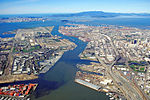Hughes Mining Barge

The Hughes Mining Barge, or HMB-1, is a submersible barge about 99 m (324 ft) long, 32 m (106 ft) wide, and more than 27 m (90 ft) tall. The HMB-1 was originally developed as part of Project Azorian (more widely, but erroneously, known as "Project Jennifer"), the top-secret effort mounted by the Central Intelligence Agency to salvage the wreckage of the Soviet submarine K-129 from the ocean floor. The HMB-1 was designed to allow the device that would be used to grasp and lift the submarine to be constructed inside the barge and out of sight, and to be installed in the Glomar Explorer in secrecy. This was done by towing the HMB-1, with the capture device inside, to a location near Catalina Island (off the coast of California), and then submerging it onto stabilizing piers that had been installed on the seafloor. The Glomar Explorer was then maneuvered over the HMB-1, the retractable roof was opened, and the capture device lifted into the massive "moon pool" of the ship, all within clear sight of people on the beach.After the conclusion of Project Azorian, the HMB-1 was mothballed at the Todd Shipyard in San Francisco, California until November 1982. At that time, the United States Navy towed the huge barge to a Lockheed Martin facility in Redwood City, California, where it became a floating drydock for the construction and sea trials of the Sea Shadow, an experimental stealth ship being tested by the Navy. Sea trials of the Sea Shadow continued until 1986.
Excerpt from the Wikipedia article Hughes Mining Barge (License: CC BY-SA 3.0, Authors, Images).Hughes Mining Barge
Main Street,
Geographical coordinates (GPS) Address Nearby Places Show on map
Geographical coordinates (GPS)
| Latitude | Longitude |
|---|---|
| N 37.791404 ° | E -122.293196 ° |
Address
Main Street 2990
94607
California, United States
Open on Google Maps





